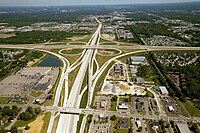
Photo from wikipedia
Abstract Most special-use freeway lanes, such as High Occupancy Vehicle (HOV) lanes, have traditionally been designed with either limited access or continuous access control from the adjacent general-purposed (GP) lanes.… Click to show full abstract
Abstract Most special-use freeway lanes, such as High Occupancy Vehicle (HOV) lanes, have traditionally been designed with either limited access or continuous access control from the adjacent general-purposed (GP) lanes. Studies have shown the advantages and disadvantages of each design in terms of safety, mobility, environment, and enforcement, among other factors. With a focus on improving the operational performance of HOV facilities, this paper proposes a new design called partially limited access control where the continuous access is mostly designated along the freeway to achieve higher travel speed while buffers between the HOV lane(s) and the adjacent GP lanes are strategically placed on selected freeway segments to accommodate higher throughput on those segments. The placement of buffers primarily aims to reduce the impact of HOV cross-weave flow on the capacity of GP lanes. In this research paper, a methodology for determining the location and length of buffers in the partially limited access control has been developed. A case study is performed along a 13-mile section of HOV facility on SR-210 E in Southern California, which is coded and evaluated in traffic microsimulation. The results show that the partially limited access control increases the throughput (represented by total vehicle miles traveled or VMT) and decreases the delay (represented by total vehicle hours traveled or VHT) of the freeway as compared with either the limited access or continuous access control. As a result, the overall efficiency (represented by average travel speed calculated as VMT/VHT) of the freeway with partially limited access HOV facility is 21% and 6% higher than that of the freeway with limited access and continuous access HOV facility, respectively, under the baseline traffic demand.
Journal Title: Transportation Research Part A: Policy and Practice
Year Published: 2018
Link to full text (if available)
Share on Social Media: Sign Up to like & get
recommendations!